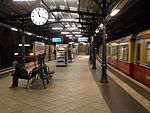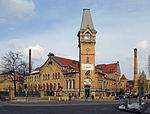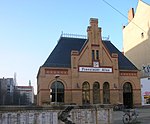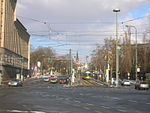Gethsemane Church

Gethsemane Church (German: Gethsemanekirche) is one of four church buildings of the Lutheran Northern Prenzlauer Berg Evangelical Congregation (German: Evangelische Kirchengemeinde Prenzlauer Berg-Nord), within the Evangelical Church of Berlin-Brandenburg-Silesian Upper Lusatia, an umbrella organisation which includes Lutheran, Reformed, and United Protestant Calvinist congregations. Gethsemane Church is the best known church in the locality of Prenzlauer Berg, in Berlin's borough of Pankow. The church was named after the Garden of Gethsemane (Old Aramaic גת שמנא, transliterated Gath Šmānê, Hebrew: גת שמנים, translit. Gath Šmānîm, lit. "oil press", transliteration in Greek: Γεθσημανή Gethsēmanḗ) at the foot of the Mount of Olives in Jerusalem. Christians revere the place as it was where the Twelve Apostles and Jesus of Nazareth prayed on the eve of his crucifixion. The church and its congregation played a crucial role before and during the Wende (or peaceful revolution) in the former German Democratic Republic (East Germany) in the autumn of 1989. The church was built between 1891 and 1893 erected following the plans of August Orth, the city's Baurat.
Excerpt from the Wikipedia article Gethsemane Church (License: CC BY-SA 3.0, Authors, Images).Gethsemane Church
Gethsemanestraße, Berlin Prenzlauer Berg
Geographical coordinates (GPS) Address Nearby Places Show on map
Geographical coordinates (GPS)
| Latitude | Longitude |
|---|---|
| N 52.5475 ° | E 13.4166666667 ° |
Address
Gethsemanestraße 2
10437 Berlin, Prenzlauer Berg
Germany
Open on Google Maps











